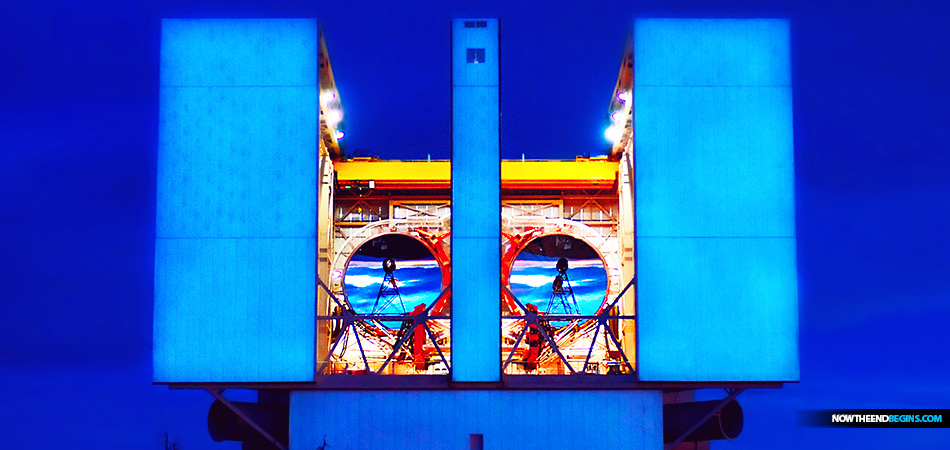
The Vatican Advanced Technology Telescope (VATT), located at the Mount Graham International Observatory in Arizona is named Lucifer.
This story is not new, goes all the way back to 2010, but seeing as we have been spending some time
talking about Judas, the
betrayer of Jesus, I thought we should take a look at the counterfeit church that is also powered by Satan, the
Roman Catholic Church. All through the Catholic church's 1,695 year history they have maintained an unbreakable connection to Lucifer. Did you know that at Easter, the Catholic Church celebrates by singing
a song dedicated to Lucifer? It's called the Exsultet, more on that in a moment.
Today we will be showing you their massive, high-powered
Vatican Advanced Technology Telescope, affectionately known as 'Lucifer'. For those of you who don't know, any reference to Lucifer is a reference to Satan.
"How art thou fallen from heaven, O Lucifer, son of the morning! how art thou cut down to the ground, which didst weaken the nations! For thou hast said in thine heart, I will ascend into heaven, I will exalt my throne above the stars of God: I will sit also upon the mount of the congregation, in the sides of the north: I will ascend above the heights of the clouds; I will be like the most High. Yet thou shalt be brought down to hell, to the sides of the pit." Isaiah 13:12-16 (KJB)
Lucifer fell and became Satan, and as you can see from the verses bearing his name in Isaiah, Lucifer is obsessed with outer space, the star, the planets, and just about everything that is connected to where Heaven is located, on the 'sides of the North' and straight up over your head. Let's take a trip to the Vatican Observatory located inside the
Steward Observatory of the University of Arizona in Tucson.
After considerable outrage and expose from Christian groups, the name of the telescope was changed from Lucifer to Luci, just as the
Lucifer Publishing Company at the United Nations changed the name to The Lucis Trust. Now they've completely covered their tracks, like Superman putting on a pair of glasses and no one can figure out he's Clark Kent.
 THE TIME THAT POPE FRANCIS IN ST. PETER’S SQUARE AT THE VATICAN DECLARED TO THE ENTIRE WORLD THAT LUCIFER IS THE GOD OF THE CATHOLIC CHURCH
THE TIME THAT POPE FRANCIS IN ST. PETER’S SQUARE AT THE VATICAN DECLARED TO THE ENTIRE WORLD THAT LUCIFER IS THE GOD OF THE CATHOLIC CHURCH
In a related topic, check this out. On April 27th, 2014, Pope Francis held a ceremony in St. Peter's Square at the Vatican to induct two former popes into sainthood. Catholic sainthood ceremonies are fairly standard procedures, and happen quite often. But on this particular occasion, Pope Francis wanted it broadcast around the world in 3D, HF and 3K. What was so special about this sainthood ceremony to go to all that expense and trouble? What was it that the pope needed the entire world to watch? As it turns out, Pope Francis was about to declare that Lucifer is the Morning Star, a title that the Bible gives to Jesus Christ alone. The pope was telling all the world that Lucifer is God of the Catholic Church.
"Oramus ergo te, Domine, ut cereus iste in honorem tui nominis consecratus, ad noctis huius caliginem destruendam, indeficiens perseveret. Et in odorem suavitatis acceptus, supernis luminaribus misceatur. Flammas eius
lucifer matutinus inveniat: Ille, inquam,
lucifer, qui nescit occasum: Ille qui regressus ab inferis, humano generi serenus illuxit."
From the Exsultet
The highlight of the ceremony was the singing of a Catholic prayer known as '
The Exsultet', or 'Easter Proclamation'. The problem starts in the wording of the prayer itself. As you can see below, twice the name of Lucifer is mentioned as you can clearly see in both the Latin and English versions. The name of Jesus is not mentioned at all. You can read all about the Roman Catholic prayer to Lucifer
by clicking here. Now let's take a look at the Lucifer telescope operated by the Vatican. If you're reading this through email, please visit this article online to watch the mind-blowing videos we;ve attached for your consideration.
Vatican-Tied Mount Graham Observatory Launched LUCIFER Telescope In 2010
FROM TRANSMISSIONS MEDIA: The Vatican Observatory Research Group (VORG) operates the 1.8m Alice P. Lennon Telescope with its Thomas J. Bannan Astrophysics Facility, known together as the Vatican Advanced Technology Telescope (VATT), at the Mount Graham International Observatory (MGIO) in southeastern Arizona where sky conditions are among the best in the world and certainly the Continental United States.
The new instrument on the Large Binocular Telescope is a powerful tool that will gain spectacular insights into the universe — from the Milky Way to extremely distant galaxies. A new instrument for the world´s largest optical telescope, the Large Binocular Telescope (LBT) on Mount Graham, allows astronomers to observe the faintest and most distant objects in the universe.
After more than a decade of design, manufacturing, and testing, the new instrument, dubbed LUCIFER 1, provides a powerful tool to gain spectacular insights into the universe — from the Milky Way to extremely distant galaxies. An identical twin instrument will be delivered to the telescope in early 2011.
“With the large light-gathering power of the LBT, astronomers are now able to collect the spectral fingerprints of the faintest and most distant objects in the universe,” said LBT director Richard Green, a professor of astronomy at the University of Arizona´s Steward Observatory.
LUCIFER 1 and its twin are mounted at the focus points of the LBT´s two giant 27.6-foot-diameter (8.4 meters) telescope mirrors. Each instrument is cooled to -351° Fahrenheit (-213° Celsius) in order to observe in the near-infrared wavelength range. Near-infrared observations are essential for understanding the formation of stars and planets in our galaxy as well as revealing the secrets of the most distant and young galaxies.
LUCIFER´s innovative design allows astronomers to observe star-forming regions in unprecedented detail, which are commonly hidden by dust clouds. The instrument is remarkably flexible, combining a large field of view with a high resolution. It provides three exchangeable cameras for imaging and spectroscopy in different resolutions, according to observational requirements.
Astronomers use spectroscopy to analyze incoming light and answer questions such as how stars and galaxies formed and what composes them.
READ MORE
No comments:
Post a Comment